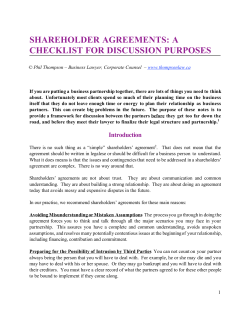
Your Company Stock Options – How to
Private Wealth Management | July 2011 Your Company Stock Options – How to Avoid Mistakes and Maximize Your Benefits By: Scott Johnson, CFP®, CPWA® and Gary Love, CFP® Stock options can be a tremendous asset and have aided many executives in the accumulation of wealth. However, a growing challenge for executives is how to manage your taxes, keep your stock options from increasing your risk in an already concentrated position, and make sure your stock option strategy fits within your overall wealth management plan. The first step for executives to take in setting a strategy for your stock options is to look at your situation and ask yourself where you would be if the value of your company stock dropped significantly. If your financial security would be at risk or your priority life objectives would be jeopardized due to this drop in value, then you should avoid adding any shares to your current position. Additional questions to consider are: 1. 2. 3. 4. What type of stock options do you own? What is your primary objective for these assets? How will these assets be used in your plan? Where do you think the stock price is going? Once you have answered these questions you will have the framework in place to make informed decisions in regard to your stock options. This framework is vital in helping you maximize the benefits of these options and achieve your objectives. The goal then of this article is to provide you with some additional perspective on each of these questions so that you can have a better understanding of how stock options can help you achieve your financial objectives. What type of stock options do you own? Stock options come in one of two basic types: Non-Qualified Stock Options (NSOs) and Incentive Stock Options (ISOs). They both give the option holder the right to purchase the stock at a predetermined price at some point in the future. However, they are taxed differently both at exercise and at sale. So, you must plan carefully at both of these critical points to help avoid making major mistakes. To help you better understand your stock options, here are some common terms with which you should be familiar: Bargain Element – The difference between the Fair Market Value on the Exercise Date and the Exercise Price. Exercise – To elect to purchase stock pursuant to an option. Exercise Date – The date that an individual purchases stock pursuant to an option. Exercise Price– The price that at which a stock can be purchased pursuant to an option. Grant Date – The date on which an option is first offered. ©2011Robert W. Baird & Co. Incorporated. Member NYSE & SIPC. Robert W. Baird & Co. 777 East Wisconsin Avenue, Milwaukee, Wisconsin 53202. 1-800-RW-BAIRD. www.rwbaird.com Page 1 of 5 Your Company Stock Options – How to Avoid Mistakes and Maximize Your Benefits, continued. What is the primary objective for theses assets? This should be the starting point for all your investment accounts including your stock options. The main objectives for options typically are tax minimization, diversification, wealth accumulation, and the funding of specific goals. Tax minimization can be a challenge because of the many moving parts surrounding the exercise and sale of stock options. This includes the possibility of having to deal with three different tax structures (1. ordinary income tax 2. capital gains tax and 3. Alternative Minimum Tax (AMT)) depending on the type of option you hold, when you exercise it, and how long you hold it after exercise. The NSO is the more straightforward of the two option types. The bargain element is taxed as ordinary income upon exercise and then any future gain is taxed as either a short-term or long-term capital gain based on the holding period beginning at the point of exercise. ISOs on the other hand can have all three tax structures apply. When the stock options are exercised, the bargain element is treated as an AMT preference item. Upon sale, this bargain element, along with any future gain, will be taxed as either a short-term or long-term capital gain based on the holding period beginning at the point of exercise. This preferential treatment is available to the option holder as long as the holding requirements are met. The holding period required for ISOs is two years from the grant date and one year from the exercise date. If this requirement is not met, then the transaction will be considered disqualified for tax purposes and the bargain element is then taxed at ordinary income tax rates in the year of sale. This can be a major disadvantage when the spread between your income tax bracket and the maximum capital gains rate is large. However, there can be times that you would purposely disqualify your transactions, such as when there has been a large increase in the price of the shares and it is determined that there is risk that the price will drop prior to the holding period requirements being fulfilled. In this case, a drop in the price of the stock is a greater risk to the portfolio than losing the advantage of capital gains treatment on the bargain element. At these critical decision points you should seek the counsel of your trusted financial advisor and accountant to make sure you maximize the benefits of the stock options you have earned. Another key objective can be transitioning a concentrated stock portfolio to a more diversified portfolio. This is a critical step for many executives who realize that any significant and prolonged drop in the price of your stock would prevent you from funding your primary objectives. In this case, an appropriate strategy involves exercising your option to purchase the shares and then later selling these shares to be reinvested into a more diversified strategy. Shares can be exercised in one of three primary ways: ©2011 Robert W. Baird & Co. Incorporated. Member NYSE & SIPC. Robert W. Baird & Co. 777 East Wisconsin Avenue, Milwaukee, Wisconsin 53202. 1-800-RW-BAIRD. www.rwbaird.com Page 2 of 5 Your Company Stock Options – How to Avoid Mistakes and Maximize Your Benefits, continued. 1. Pay cash – The easiest method. 2. Cashless exercise – Borrowed funds are used to purchase the shares at the exercise price. Then, the shares are immediately sold with the investor keeping the difference between the exercise price and the sale price of the stock at exercise. 3. Stock swap – Shares of company stock that are already owned are used to buy the shares pursuant to the option. This method can be useful when the individual wants to build upon their existing position. This leads to another common objective for stock options, which is to accumulate more shares of the stock in anticipation of future price appreciation. You can accomplish this by exercising, or purchasing, the available options with cash or shares of stock and then holding them in your portfolio. The major advantage of this strategy is that you maximize your gain if the price of the shares increases. However, you should only use this strategy after a comprehensive review of your wealth management plan to be certain that the additional shares that you obtain do not place your financial future at risk due to concentration risk. What will these assets be used for in your plan? This question assumes the exercise and sale of the optioned shares are earmarked to fund a specific objective. These objectives could include a wide variety of items such as retirement, starting/buying a business, buying real estate or another major purchase, educational costs for children or grandchildren, leaving an inheritance, or charitable giving. Once you determine this, you can set the price that the stock needs to reach before you exercise and sell the options. It is evident that what to do with your stock options should be based on how these assets fit into your overall plan. However, the decision as to when to exercise can also depend on where you think the stock price is going, which brings in the emotional side to this process. Which direction do you think the stock price is going? This is the most challenging piece of the process we have looked at thus far for two primary reasons. One, there are so many variables that can determine the price of a stock that no one can predict it with certainty at any given point in time. And, in addition to answering this question, your emotions as an investor should be considered as they can present a significant challenge to making an objective decision. So, how can you come to an objective decision regarding the future price of your company stock? Here are a few points to consider: 1. Do your homework by reviewing the opinion of at least three different analysts covering your stock and set realistic price targets. This can help you arrive at a better decision less shaped by just your own opinion. 2. Compare your findings to a diversified portfolio and determine which has the best risk-adjusted returns. The best choice can become very clear once this has been done. (Please see our article on Stock Concentration Risk - Is It Worth Taking? for a closer look at this topic.) ©2011 Robert W. Baird & Co. Incorporated. Member NYSE & SIPC. Robert W. Baird & Co. 777 East Wisconsin Avenue, Milwaukee, Wisconsin 53202. 1-800-RW-BAIRD. www.rwbaird.com Page 3 of 5 Your Company Stock Options – How to Avoid Mistakes and Maximize Your Benefits, continued. 3. Evaluate your emotions and try to limit them within the decision making process. These emotions can become a major stumbling block to sound financial investing. This can be particularly true of someone who was worked many years at the company and seen the share price increase substantially over the years. In this case, it is very easy to become overconfident and make poor decisions. It is investment legend Benjamin Graham who may have said it best, “The investor's chief problem - and even his worst enemy - is likely to be himself.” So, the first step to overcoming these biases is to acknowledge that they exist. Consider the following example: Joe Executive, age 55, works at ABC Company. He has been with the company for more than 20 years and has 75% of his net worth tied up in his company stock, and he has 10,000 ISOs vesting each of the next three years. His main goal is to retire within the next five years. Joe is very concerned about the concentration of his portfolio in his company stock but is not sure what he should do. He is also very concerned about taxes. What should he consider when making a decision on what to do with his options? · He should evaluate whether or not a major decline in the share price would allow him to achieve his retirement objective. With 75% of his portfolio in ABC stock, he determines that he needs to begin diversifying his portfolio to reduce his concentration risk. So, he decides that he should not add to this position further through his stock options and plans to exercise and then later sell the shares. · Now that he has made this decision, his next challenge is to do this in a tax-efficient manner. He is in a good position here as his ISOs are the more tax-advantaged of the two option types. As long as he meets both parts of the holding requirement – two years from the grant date and one year from exercise – he will pay capital gains taxes on both the bargain element and the appreciation of the stock price upon the sale of these shares. He decides to review this strategy with his tax planner before exercising any of his options. · Next, Joe needs to decide how he is going to pay for the shares of ABC stock at exercise. His plan allows for a cashless exercise, but since he plans to hold the shares for a year following exercise, this method will not work for him. He decides to sell enough shares of his existing ABC stock that qualify for long-term capital gains treatment now to fund the exercise. Thus, he has created an exercise strategy that begins to reduce his concentration risk. · His last step is to sell the 10,000 shares he exercised after one year has elapsed and invest the proceeds of these shares into a more diversified portfolio that is better aligned with his retirement objective. · The biggest risk to this option strategy is a decline in the price of the stock after exercise and before he sells these shares. So, Joe sits down with his financial advisor to analyze the direction of the stock and to discuss strategies to help mitigate the risk of a major price decline. ©2011 Robert W. Baird & Co. Incorporated. Member NYSE & SIPC. Robert W. Baird & Co. 777 East Wisconsin Avenue, Milwaukee, Wisconsin 53202. 1-800-RW-BAIRD. www.rwbaird.com Page 4 of 5 Your Company Stock Options – How to Avoid Mistakes and Maximize Your Benefits, continued. As you can see, the key to your success lies in how you develop your own financial plan as it should be the foundation for all your investment decisions, not just the ones related to your stock options. Your plan must be developed with a thorough examination of who you are, what you want your money to do for you, and where you want to be in five or ten years and beyond. These answers will provide you with a firm foundation for making portfolio allocation decisions and addressing risk and return. In the end, decisions concerning stock options should be based upon your plan and not the latest headlines. Following the plan will help you eliminate the emotional component of investment decision making and help you make stronger decisions that can help you achieve your goals. A disciplined wealth management process then becomes the guide to your investment success. If you have questions, or have not developed a strategy for your stock options, we would be happy to help you take the next steps. Please join us for our upcoming conference call or call or e-mail us directly. BY: Scott Johnson, CFP®, CPWA® and Gary Love, CFP® The Love Johnson Group Robert W. Baird and Company Private Wealth Management 815-636-5225 ● thelovejohnsongroup.com The opinions expressed are those of the authors and not necessarily of Robert W. Baird and Company. Diversification does not guarantee a profit and does not ensure against a loss. Robert W. Baird and Company does not provide tax advice. Please consult with your tax professional. Investment Management Consultants Association is the owner of the certification mark “CPWA®” and the service marks “Certified Private Wealth Advisor℠”, “Investment Management Consultants Association℠ ,” and “IMCA®”. Use of CPWA® or Certified Private Wealth Advisor℠ signifies that the user has successfully completed IMCA’s initial and ongoing credentialing requirements for wealth advisors. ©2011 Robert W. Baird & Co. Incorporated. Member NYSE & SIPC. Robert W. Baird & Co. 777 East Wisconsin Avenue, Milwaukee, Wisconsin 53202. 1-800-RW-BAIRD. www.rwbaird.com Page 5 of 5
© Copyright 2025





















